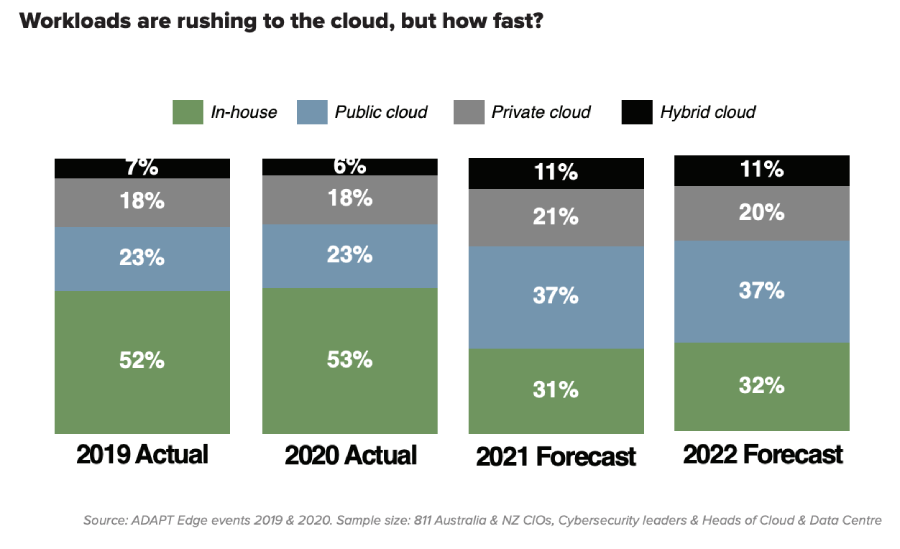Cloud computing offers organisations undeniable benefits like speed to market, adaptability, responsiveness, and flexibility. To harness the power of cloud, it’s critical for leaders to understand the costs, benefits and ROI of cloud migration and services; cloud economics.
While many businesses see cloud as a lower cost alternative, the reality is that private, public and multicloud computing isn’t necessarily cheaper than on-premises infrastructure.
To effectively apply cloud economics principles, businesses must engage with:
It’s no surprise that enterprise cloud computing experienced a staggering level of growth in the first half of 2020 alone. A decade-long cloud growth spurt was spurred to new heights by the tech demands imposed by the coronavirus pandemic.
Both Microsoft Azure and Google Cloud recorded over 50% growth in their first and second earnings reports of 2020, with a 33% and 29% growth rate in those respective periods for AWS. That growth includes an astounding 48% growth in revenue in the September 2020 quarter alone for Microsoft Azure.
There are no signs that the growth trend, driven by increasing cloud adoption and cloud computing usage within organisations, has peaked. Recent cloud research reported cloud spend was over budget by 23% on average, with expectations for spend to increase by 47% in the next year.
While the pandemic has sparked a fresh look at cloud computing, the accelerated takeup was already in the pipeline before coronavirus; businesses were planning to shift nearly 50% of workloads to cloud by 2020 and were anticipating almost 40% of workloads to shift to public cloud alone in 2021.
The diagram below from the RE:IMAGINE your IT business continuity ADAPT research report shows a clear trend towards evening out the balance between inhouse, public, private and hybrid cloud.

Data suggests that organisations waste as much as 30 percent of their cloud spend. While cloud enables functionality beyond on-premises – virtual apps supporting remote work is a critical example in the current market – cloud services are not always in sync with business value.
Organisations who understand the principles of cloud economics are better equipped to hold cloud accountable and invest in cloud services that drive business value.
Working with a partner like Canon Business Services (formerly Harbour IT) opens the door to a portfolio that can support private and public cloud. Our cloud experts help businesses choose the right cloud configuration for their business conditions and workflows. The most robust solution? A multi-cloud or holistic cloud strategy spreading risk and reward across on-premises, private and public could.
Choosing the cloud solution to meet your business objectives and your budget demands a consideration of your specific business workflows:
Executive buy-in is critical to accessing the full benefits of cloud computing. Cloud migrations and provider shifts rarely succeed without executive alignment; the process can require significant investments of time, money, and resources.
Cloud economics best-practice needs a thorough analysis of existing infrastructure and application usage to see what can be rehosted or replatformed, and what must be rearchitected (and replaced and retired). Without going through a broader executive level assessment to determine cloud functionality needs, your business risks accruing technical debt by creating a piecemeal system that doesn’t deliver on the full value of cloud computing.
Executive buy-in needs to come from the entire C-suite – it isn’t just CIOs and CTOs that need to be onboard. From the CEO down, the team must believe in the benefits of cloud enough to commit to funding the migration process and ongoing operating expenses.
Cloud computing may be the business solution you need, but it’s critical to assess the economics of the solutions on offer – from migration through to ongoing maintenance.
Making your enterprise cloud computing as cost-effective as possible needs to consider a range of factors:
Adopt a multi-cloud approach to fit your workloads to the right environments. For example:
You don’t need to choose a single cloud computing environment – a hybrid cloud approach to combining environments frees you to choose the best service providers for every business need integrated under a unified security policy.
Imagine scaling up for planned peak use, and then forgetting to turn the dial back down. If the business mentality is simply that ‘cloud is always cheaper’, there is a greater risk of losing cloud accountability and defying cloud economics. Workflows that dictate important follow-up steps – such as turning off VMs or extra capacity when it isn’t needed – can limit unnecessary billing.
Another simple but often overlooked cost-management tool: keeping close tabs on access to systems or applications. Regular scheduled reviews of licencing and provisioning can catch any usage leaks.
Cloud computing is generally billed on what you’ve used, but your invoice may not list your specific usage. If you can’t identify the costs your invoices cover, ask for more information. Diving deeper can be a good way to spot opportunities to adjust how and where cloud resources are being used – enabling greater cost control particularly across private cloud.
Keeping cloud cost-effective requires a solid grasp of cloud economics – and regular monitoring from specialist talent in-house or a third-party cloud services provider like Canon Business Services (CBS).
Working with a proven partner like CBS may be a cost-effective alternative to hiring in-house staff, without risking your cloud environment and performance. Enlisting CBS to manage your Cloud Services makes it possible to leverage operational talent on demand – scaling services up or down in response to your company’s demand.
That makes good cloud sense.
Ask the expert team at Canon Business Services about Cloud Services to support your business.